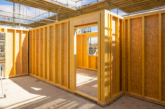Oliver Baker, CEO at Ambion Heating, outlines one path to low carbon heating in new homes.
On any housing development project, efficiency is key. Housebuilders want to minimise their time on-site by working efficiently, and they want the build to be as cost-efficient as possible, too. With sustainability standards increasing, many are also focused on improving the energy efficiency of their properties – which means finding low-carbon alternatives to traditional materials, fixtures and fittings.
According to the Climate Change Committee, the UK’s homes are responsible for around 15% of our overall carbon emissions, which means the Government is putting increasing pressure on housebuilders to improve the energy efficiency of new build properties by introducing legislation such as the Future Homes Standard. Under this, all new homes will be expected to produce 31% lower carbon emissions from 2021. By 2025, however, the Future Homes Standard will require new build homes to have ‘world-leading levels of energy efficiency’.
With less than four years until the Future Homes Standard comes into force, housebuilders are already preparing to deliver higher standards of energy efficiency by putting efficiency at the heart of their projects, from design to procurement. And it seems that their efforts are paying off, as, according to Government figures, 84% of new homes delivered in England between October and December 2020 were given an energy efficiency rating of A or B.
To ensure efficiency improvements don’t impact their bottom line, however, housebuilders must find efficient solutions that are quick and easy to install and cost-effective.
A future-proof solution
One of the critical elements of the Future Homes Standard is the ban on fossil-fuelled heating in new builds from 2025, which means many housebuilders are seeking their ideal low-carbon heating solution. They need to find a heating solution that will help them to keep costs and carbon emissions low, and also provide their homeowners with a high quality, comfortable form of heating.
One solution is computer-controlled infrared (CCIR) heating, a ‘next generation’ solution for low-carbon heating systems. In-built processors and sensors give it the unique ability to adapt to the environment it is operating in and optimise heat settings accordingly. This enables homeowners to benefit from high-performance and cost-effective heating, achieving comfortable temperatures using fewer units of energy than a traditional heating system.
CCIR heating also benefits housebuilders because:
- It’s future-proof – CCIR uses up to 60% less energy than a traditional convection heating system, and it’s powered by electricity rather than gas, which means it meets the requirements of the Future Homes Standard
- It’s easy and cost-effective to install – as it is simply wired into the mains, CCIR is not only simple to install, it also costs around 40% less than an air source heat pump (ASHP).
- It is built to last – CCIR has no moving parts and requires no annual maintenance, meaning the risk of warranty claims is reduced.
Housebuilders can expect further government guidance on energy efficiency this year, as policies like the Heat and Building Strategy and the Net Zero Strategy are set to be published in the coming months. However, future-focused housebuilders will be acting now to ensure that they find a low-carbon heating system that meets their needs and those of homeowners.










